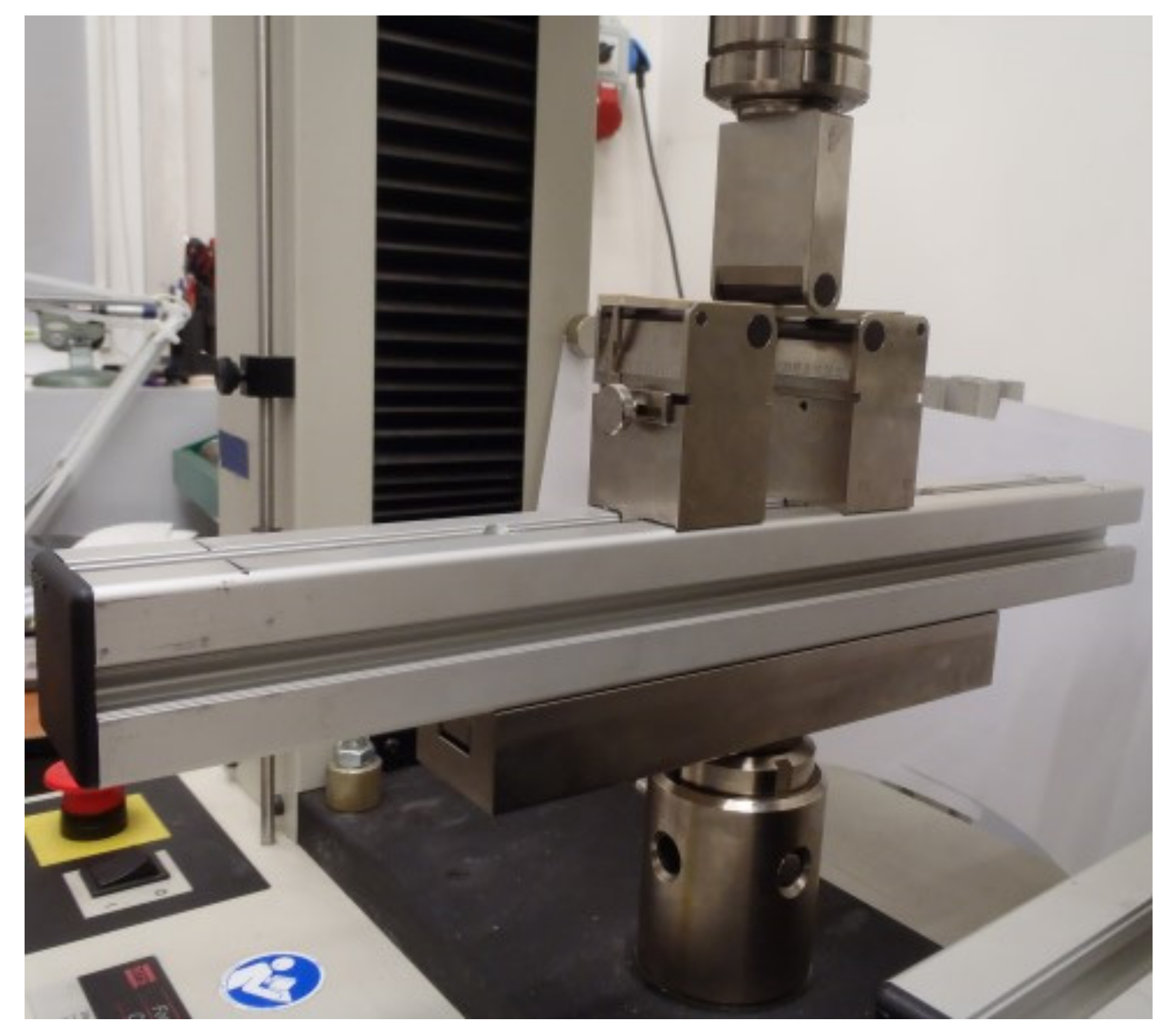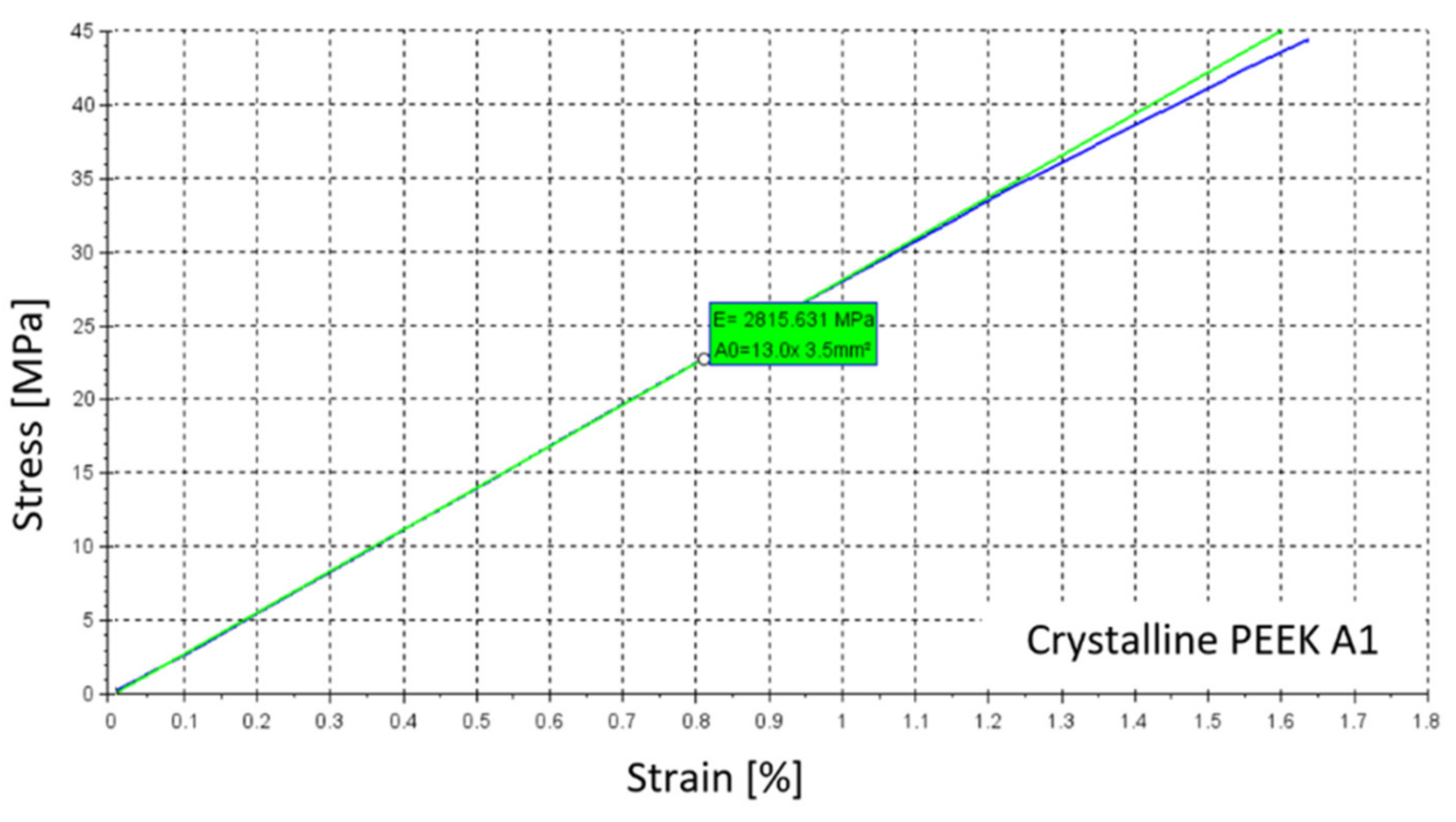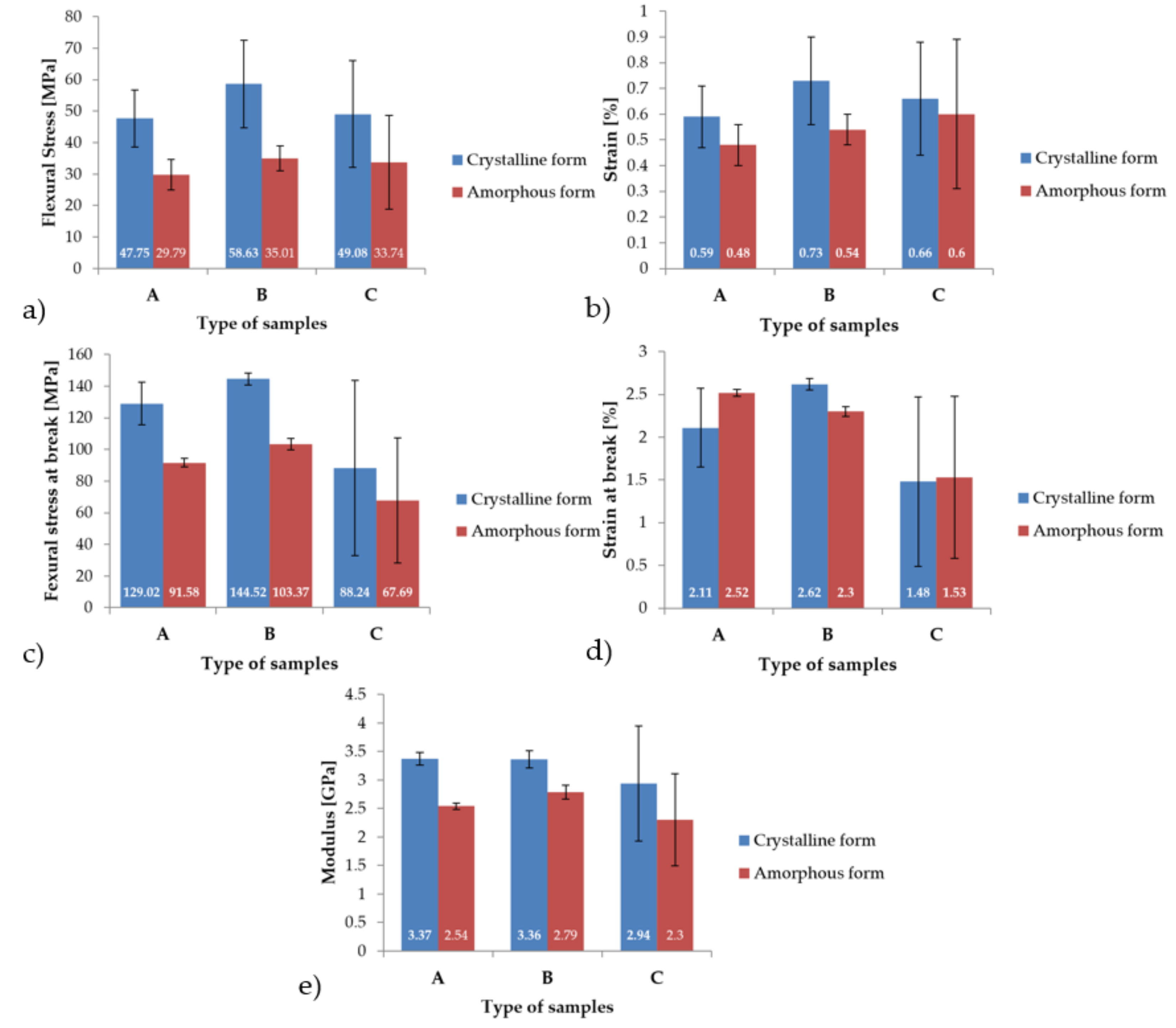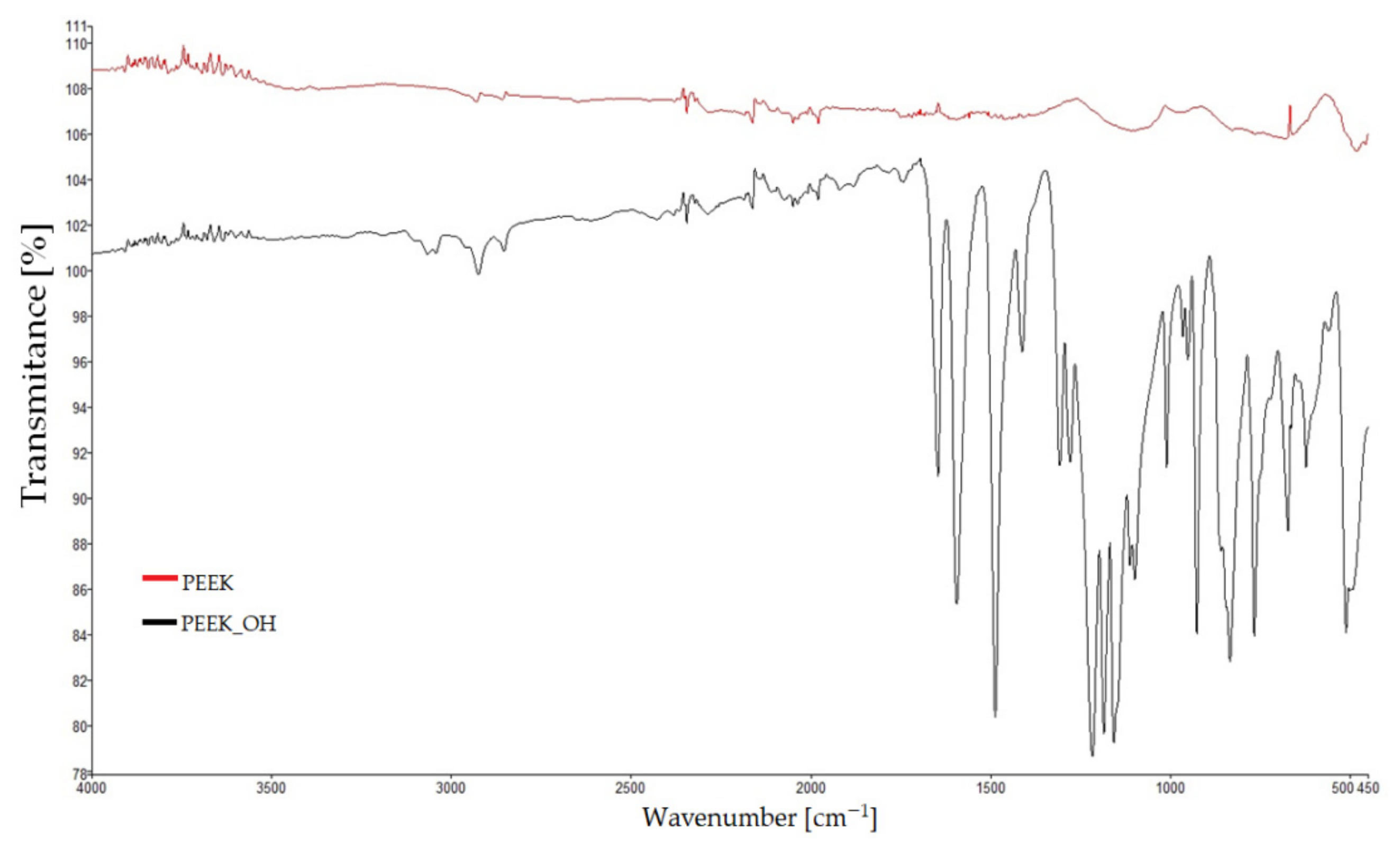Mechanical, Chemical, and Processing Properties of Specimens Manufactured from Poly-Ether-Ether-Ketone (PEEK) Using 3D Printing
Abstract
1. Introduction
2. Materials and Methods
2.1. Strength Analysis Using a Static Uniaxial Tensile Method
2.2. Three-Point Bending Experiments
2.3. Impact Experiments
2.4. Chemical Modifications of PEEK
2.5. Determining Processing Properties
3. Results
3.1. Results of the Uniaxial Tensile Testing
3.2. Results of Three-Point Bending Testing
3.3. Results of Impact Testing
3.4. Infrared Spectroscopy
3.5. Results of Chemical Modifications of PEEK
4. Conclusions
Author Contributions
Funding
Institutional Review Board Statement
Informed Consent Statement
Data Availability Statement
Conflicts of Interest
References
- Krzyzak, A.; Kosicka, E.; Szczepaniak, R. Research into the Effect of Grain and the Content of Alundum on Tribological Properties and Selected Mechanical Properties of Polymer Composites. Materials 2020, 13, 5735. [Google Scholar] [CrossRef] [PubMed]
- Pach, J.; Mayer, P.; Jamroziak, K.; Polak, S.; Pyka, D. Experimental analysis of puncture resistance of aramid laminates on styrene-butadiene-styrene and epoxy resin matrix for ballistic applications. Arch. Civ. Mech. Eng. 2019, 19, 1327–1337. [Google Scholar] [CrossRef]
- Kosicka, E.; Borowiec, M.; Kowalczuk, M.; Krzyzak, A.; Szczepaniak, R. Influence of the Selected Physical Modifier on the Dynamical Behavior of the Polymer Composites Used in the Aviation Industry. Materials 2020, 13, 5479. [Google Scholar] [CrossRef]
- Hejna, A.; Lenża, J.; Formela, K.; Korol, J. Studies on the Combined Impact of Starch Source and Multiple Processing on Selected Properties of Thermoplastic Starch/Ethylene-Vinyl Acetate Blends. J. Polym. Environ. 2019, 27, 1112–1126. [Google Scholar] [CrossRef]
- Pach, J.; Pyka, D.; Jamroziak, K.; Mayer, P. The experimental and numerical analysis of the ballistic resistance of polymer composites. Compos. Part B Eng. 2017, 113, 24–30. [Google Scholar] [CrossRef]
- Krzyzak, A.; Racinowski, D.; Szczepaniak, R.; Mucha, M.; Kosicka, E. The Impact of Selected Atmospheric Conditions on the Process of Abrasive Wear of CFRP. Materials 2020, 13, 3965. [Google Scholar] [CrossRef] [PubMed]
- Olesik, P.; Godzierz, M.; Kozioł, M. Preliminary Characterization of Novel LDPE-Based Wear-Resistant Composite Suitable for FDM 3D Printing. Materials 2019, 12, 2520. [Google Scholar] [CrossRef] [PubMed]
- Figlus, T.; Kozioł, M.; Kuczyński, Ł. Impact of Application of Selected Composite Materials on the Weight and Vibroactivity of the Upper Gearbox Housing. Materials 2019, 12, 2517. [Google Scholar] [CrossRef] [PubMed]
- Mrówka, M.; Woźniak, A.; Prężyna, S.; Sławski, S. The Influence of Zinc Waste Filler on the Tribological and Mechanical Properties of Silicone-Based Composites. Polymers 2021, 13, 585. [Google Scholar] [CrossRef] [PubMed]
- Sławski, S.; Szymiczek, M.; Kaczmarczyk, J.; Domin, J.; Świtoński, E. Low Velocity Impact Response and Tensile Strength of Epoxy Composites with Different Reinforcing Materials. Materials 2020, 13, 3059. [Google Scholar] [CrossRef]
- Duda, S.; Kciuk, S.; Machoczek, T.; Sławski, S. Implications of the Lifting Method on Stress Distribution in the Conveyor Belt. In Modelling in Engineering 2020: Applied Mechanics. SMWM 2020. Advances in Intelligent Systems and Computing; Mężyk, A., Kciuk, S., Szewczyk, R., Duda, S., Eds.; Springer International Publishing: Cham, Switzerland, 2021; Volume 1336, pp. 53–60. [Google Scholar]
- Szarek, A.; Stradomski, G.; Łukomska-Szarek, J.; Rydz, D.; Wolański, W.; Joszko, K. Wear Morphology on the Surfaces of CoCrMo Unicompartmental Knee Joint Endoprostheses as Elements of Metal-Metal Friction Nodes. Materials 2020, 13, 2689. [Google Scholar] [CrossRef] [PubMed]
- Mrowka, M.; Szymiczek, M.; Machoczek, T.; Lenza, J.; Matusik, J.; Sakiewicz, P.; Skonieczna, M. The influence of halloysite on the physicochemical, mechanical and biological properties of polyurethane-based nanocomposites. Polimery-W 2020, 65, 784–791. [Google Scholar] [CrossRef]
- Mrówka, M.; Jaszcz, K.; Skonieczna, M. Anticancer activity of functional polysuccinates with N-acetyl-cysteine in sidechains. Eur. J. Pharmacol. 2020, 885, 173501. [Google Scholar] [CrossRef] [PubMed]
- Ichikawa, T.; Kurahashi, K.; Liu, L.; Matsuda, T.; Ishida, Y. Use of a Polyetheretherketone Clasp Retainer for Removable Partial Denture: A Case Report. Dent. J. 2019, 7, 4. [Google Scholar] [CrossRef] [PubMed]
- Ji, S.; Sun, C.; Zhao, J.; Liang, F. Comparison and Analysis on Mechanical Property and Machinability about Polyetheretherketone and Carbon-Fibers Reinforced Polyetheretherketone. Materials 2015, 8, 4118–4130. [Google Scholar] [CrossRef]
- Garcia-Gonzalez, D.; Rusinek, A.; Jankowiak, T.; Arias, A. Mechanical impact behavior of polyether–ether–ketone (PEEK). Compos. Struct. 2015, 124, 88–99. [Google Scholar] [CrossRef]
- Simsiriwong, J.; Shrestha, R.; Shamsaei, N.; Lugo, M.; Moser, R.D. Effects of microstructural inclusions on fatigue life of polyether ether ketone (PEEK). J. Mech. Behav. Biomed. Mater. 2015, 51, 388–397. [Google Scholar] [CrossRef]
- Evans, N.T.; Torstrick, F.B.; Lee, C.S.; Dupont, K.M.; Safranski, D.L.; Chang, W.A.; Macedo, A.E.; Lin, A.S.; Boothby, J.M.; Whittingslow, D.C.; et al. High-strength, surface-porous polyether-ether-ketone for load-bearing orthopedic implants. Acta Biomater. 2015, 13, 159–167. [Google Scholar] [CrossRef]
- Najeeb, S.; Zafar, M.S.; Khurshid, Z.; Siddiqui, F. Applications of polyetheretherketone (PEEK) in oral implantology and prosthodontics. J. Prosthodont. Res. 2016, 60, 12–19. [Google Scholar] [CrossRef]
- Panayotov, I.V.; Orti, V.; Cuisinier, F.; Yachouh, J. Polyetheretherketone (PEEK) for medical applications. J. Mater. Sci. Mater. Med. 2016, 27, 118. [Google Scholar] [CrossRef]
- Haleem, A.; Javaid, M. Polyether ether ketone (PEEK) and its 3D printed implants applications in medical field: An overview. Clin. Epidemiol. Glob. Health 2019, 7, 571–577. [Google Scholar] [CrossRef]
- Kersten, R.F.M.R.; van Gaalen, S.M.; de Gast, A.; Öner, F.C. Polyetheretherketone (PEEK) cages in cervical applications: A systematic review. Spine J. 2015, 15, 1446–1460. [Google Scholar] [CrossRef] [PubMed]
- Deng, X.; Zeng, Z.; Peng, B.; Yan, S.; Ke, W. Mechanical Properties Optimization of Poly-Ether-Ether-Ketone via Fused Deposition Modeling. Materials 2018, 11, 216. [Google Scholar] [CrossRef] [PubMed]
- Wu, W.; Geng, P.; Li, G.; Zhao, D.; Zhang, H.; Zhao, J. Influence of Layer Thickness and Raster Angle on the Mechanical Properties of 3D-Printed PEEK and a Comparative Mechanical Study between PEEK and ABS. Materials 2015, 8, 5834–5846. [Google Scholar] [CrossRef] [PubMed]
- Rinaldi, M.; Ghidini, T.; Cecchini, F.; Brandao, A.; Nanni, F. Additive layer manufacturing of poly (ether ether ketone) via FDM. Compos. Part B Eng. 2018, 145, 162–172. [Google Scholar] [CrossRef]
- Leong, J.X.; Daud, W.R.W.; Ghasemi, M.; Ahmad, A.; Ismail, M.; Ben Liew, K. Composite membrane containing graphene oxide in sulfonated polyether ether ketone in microbial fuel cell applications. Int. J. Hydrogen Energy 2015, 40, 11604–11614. [Google Scholar] [CrossRef]
- Conceição, T.F.; Bertolino, J.R.; Barra, G.M.O.; Mireski, S.L.; Joussef, A.C.; Pires, A.T.N. Preparation and characterization of poly(ether ether ketone) derivatives. J. Braz. Chem. Soc. 2008, 19, 111–116. [Google Scholar] [CrossRef]
- ASTM D790-02. Standard Test Methods for Flexural Properties of Unreinforced and Reinforced Plastics and Electrical Insulating Materials; ASTM International: West Conshohocken, PA, USA, 2002; Available online: www.astm.org (accessed on 16 October 2020).
- ASTM D256-02. Standard Test Methods for Determining the Izod Pendulum Impact Resistance of Plastics; ASTM International: West Conshohocken, PA, USA, 2002; Available online: www.astm.org (accessed on 16 October 2020).
- Sviridov, A.; Lopatina, I.; Kurganova, I. 3D-printed polyether ether ketone samples mechanical properties estimation. IOP Conf. Ser. Mater. Sci. Eng. 2019, 589, 012021. [Google Scholar] [CrossRef]
- Hoskins, T.; Dearn, K.; Kukureka, S. Mechanical performance of PEEK produced by additive manufacturing. Polym. Test. 2018, 70, 511–519. [Google Scholar] [CrossRef]
- Zhao, F.; Li, D.; Jin, Z. Preliminary Investigation of Poly-Ether-Ether-Ketone Based on Fused Deposition Modeling for Medical Applications. Materials 2018, 11, 288. [Google Scholar] [CrossRef]











| Name of Samples | Stress at Yield [MPa] | Strain at YIELD [mm/mm] | Stress at Break [MP] | Strain at Break [mm/mm] | Modulus of Elasticity [GPa] | Poisson’s Ratio |
|---|---|---|---|---|---|---|
| Sample A | 26.86 ± 0.56 | 0.0096 ± 0 | 43.67 ± 0.07 | 0.016 ± 0 | 2.79 ± 0.03 | 0.38 ± 0 |
| Sample B | 27.19 ± 1.11 | 0.0096 ± 0 | 38.76 ± 1.9 | 0.013 ± 0 | 2.83 ± 0.15 | 0.38 ± 0 |
| Sample C | 5.80 ± 1.49 | 0.0022 ± 0 | 12.21 ± 2.4 | 0.0043 ± 0 | 2.69 ± 0.51 | 0.35 ± 0.02 |
| Name of Samples | Stress at Yield [MPa] | Strain at Yield [mm/mm] | Stress at Break [MPa] | Strain at Break [mm/mm] | Modulus of Elasticity [GPa] | Poisson’s Ratio |
|---|---|---|---|---|---|---|
| Sample A | 26.73 ± 0.52 | 0.011 ± 0 | 43.08 ± 0.12 | 0.022 ± 0 | 2.25 ± 0.05 | 0.40 ± 0.01 |
| Sample B | 22.51 ± 0.99 | 0.0094 ± 0 | 43.67 ± 0.13 | 0.021 ± 0 | 2.38 ± 0.03 | 0.39 ± 0.01 |
| Sample C | 4.82 ± 0.26 | 0.0022 ± 0 | 10.03 ± 0.87 | 0.0045 ± 0 | 2.18 ± 0.17 | 0.36 ± 0.02 |
| Name of Samples | Stress at Yield [MPa] | Strain at Yield [%] | Stress at Break [MPa] | Strain at Break [%] | Modulus of Elasticity [GPa] |
|---|---|---|---|---|---|
| Sample A | 47.75 ± 9.06 | 0.59 ± 0.12 | 129.02 ± 13.45 | 2.11 ± 0.46 | 3.37 ± 0.11 |
| Sample B | 58.63 ± 13.87 | 0.73 ± 0.17 | 144.52 ± 3.61 | 2.62 ± 0.07 | 3.36 ± 0.15 |
| Sample C | 49.08 ± 16.79 | 0.66 ± 0.22 | 88.24 ± 53.29 | 1.48 ± 0.99 | 2.94 ± 1.01 |
| Name of Samples | Stress at Yield [MPa] | Strain at Yield [%] | Stress at Break [MPa] | Strain at Break [%] | Modulus of Elasticity [GPa] |
|---|---|---|---|---|---|
| Sample A | 29.79 ± 4.81 | 0.48 ± 0.08 | 91.58 ± 2.77 | 2.52 ± 0.04 | 2.54 ± 0.06 |
| Sample B | 35.01 ± 4.01 | 0.54 ± 0.06 | 103.37 ± 3.74 | 2.30 ± 0.06 | 2.79 ± 0.12 |
| Sample C | 33.74 ± 14.94 | 0.60 ±0.29 | 67.69 ± 39.52 | 1.53 ± 0.95 | 2.30 ± 0.81 |
| Name of Samples | Impact Resistance [kJ/m2] | |
|---|---|---|
| Amorphous Form | Crystalline Form | |
| Sample A | 12.80 | 7.66 |
| Sample B | 21.16 | 14.59 |
| Sample C | 12.60 | 6.57 |
| Sample N | 112.09 | 23.96 |
Publisher’s Note: MDPI stays neutral with regard to jurisdictional claims in published maps and institutional affiliations. |
© 2021 by the authors. Licensee MDPI, Basel, Switzerland. This article is an open access article distributed under the terms and conditions of the Creative Commons Attribution (CC BY) license (https://creativecommons.org/licenses/by/4.0/).
Share and Cite
Mrówka, M.; Machoczek, T.; Jureczko, P.; Joszko, K.; Gzik, M.; Wolański, W.; Wilk, K. Mechanical, Chemical, and Processing Properties of Specimens Manufactured from Poly-Ether-Ether-Ketone (PEEK) Using 3D Printing. Materials 2021, 14, 2717. https://doi.org/10.3390/ma14112717
Mrówka M, Machoczek T, Jureczko P, Joszko K, Gzik M, Wolański W, Wilk K. Mechanical, Chemical, and Processing Properties of Specimens Manufactured from Poly-Ether-Ether-Ketone (PEEK) Using 3D Printing. Materials. 2021; 14(11):2717. https://doi.org/10.3390/ma14112717
Chicago/Turabian StyleMrówka, Maciej, Tomasz Machoczek, Paweł Jureczko, Kamil Joszko, Marek Gzik, Wojciech Wolański, and Krzysztof Wilk. 2021. "Mechanical, Chemical, and Processing Properties of Specimens Manufactured from Poly-Ether-Ether-Ketone (PEEK) Using 3D Printing" Materials 14, no. 11: 2717. https://doi.org/10.3390/ma14112717
APA StyleMrówka, M., Machoczek, T., Jureczko, P., Joszko, K., Gzik, M., Wolański, W., & Wilk, K. (2021). Mechanical, Chemical, and Processing Properties of Specimens Manufactured from Poly-Ether-Ether-Ketone (PEEK) Using 3D Printing. Materials, 14(11), 2717. https://doi.org/10.3390/ma14112717








